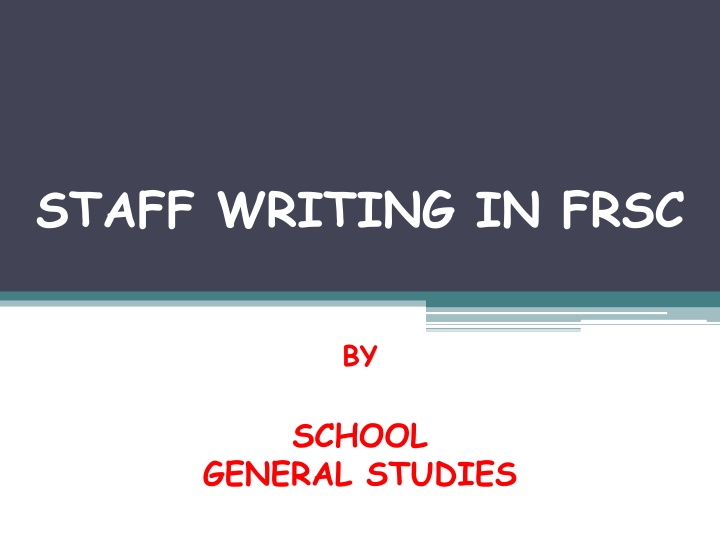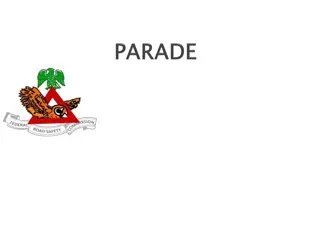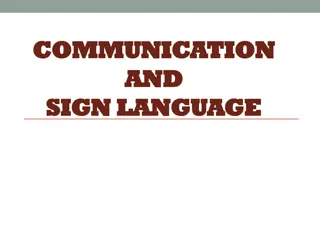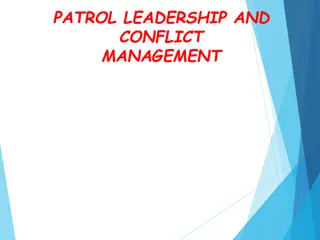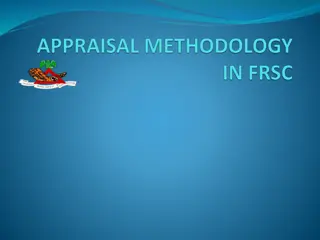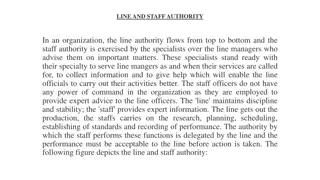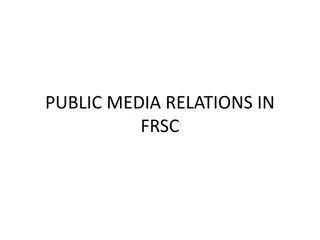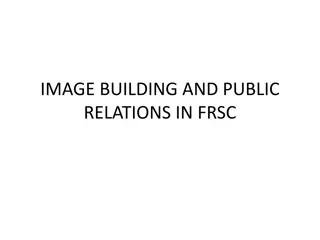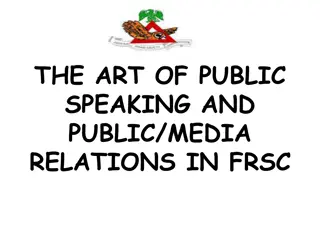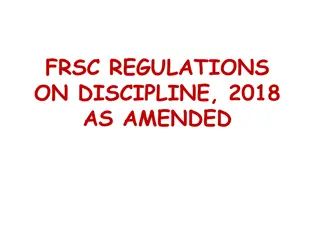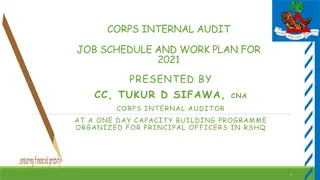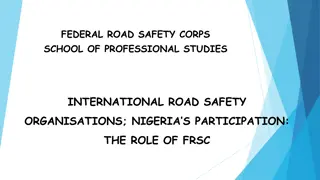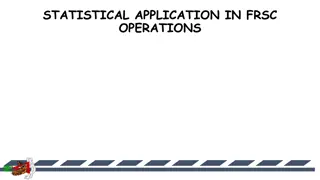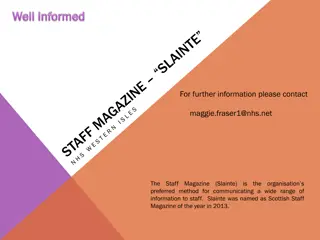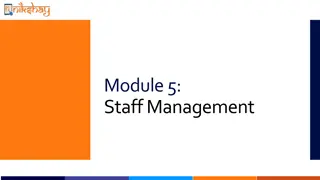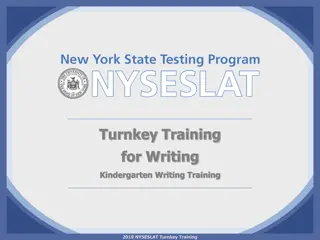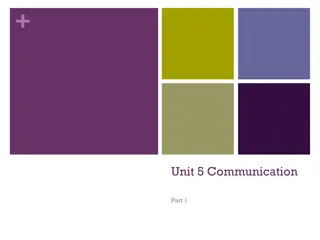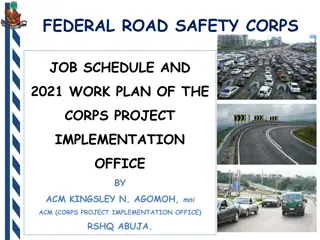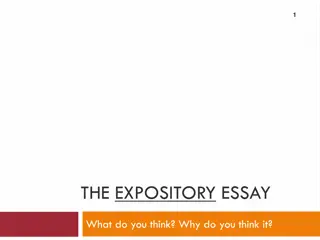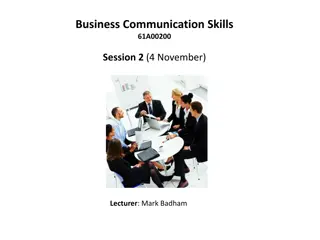Effective Communication Practices in FRSC: A Guide to Staff Writing
Staff writing in the Federal Road Safety Corps (FRSC) is crucial for standardized communication. This guide covers the importance, types, characteristics, basic rules, and conventions of service writing in FRSC. Participants will learn how to apply these guidelines effectively for clear and concise communication within and outside the organization.
Download Presentation

Please find below an Image/Link to download the presentation.
The content on the website is provided AS IS for your information and personal use only. It may not be sold, licensed, or shared on other websites without obtaining consent from the author.If you encounter any issues during the download, it is possible that the publisher has removed the file from their server.
You are allowed to download the files provided on this website for personal or commercial use, subject to the condition that they are used lawfully. All files are the property of their respective owners.
The content on the website is provided AS IS for your information and personal use only. It may not be sold, licensed, or shared on other websites without obtaining consent from the author.
E N D
Presentation Transcript
STAFF WRITING IN FRSC BY SCHOOL GENERAL STUDIES
INTRODUCTION Staff writing is a standardized way of communication. Even though it is peculiar to an organization, it must also meet the basic minimum of internationally accepted standard. A standardized writing method becomes necessary in order to communicate logically, concisely, accurately and so on. The Federal Road Safety Corps has developed a standardized writing manual to guide its communication within the organization and with the outside world. This is aimed at reducing the official time in coping with extracting information from diverse writing methods
AIM Introduce the participants to the FRSC service writing.
OBJECTIVES At the end of the presentation participants shall be able to: list Types of writing Explain the Characteristics of Service Writing Apply the Basic rules and conventions in service writings Explain types of FRSC Correspondence Explain process of Filling and securing document Explain the role of chairman in Conferences, and meetings Explain Brief and list types of briefs
TYPES OF WRITING Operational writing- abbreviation can be used here, it includes: Administrative Orders Part I and II order Signal & Wireless Messages Internal Memos All Forms of Ops Reports Non operational writing- Covers all other forms of writing from FRSC to other Organizations. Use of abbreviation is restricted. Follows normal English rules.
CHARACTERISTICS OF COMMISSION WRITING Accuracy Brevity Clarity Relevance Logical
BASIC RULES AND CONVENTIONS The basic rules of Commission writing aid the clear presentation of facts and discussion. It helps Staff to conform to standard layout. Documents are made up of three (3) parts: Superscript before text Text Subscript- after text The contents of each part may vary with document, but in all cases the superscript comprises everything above the text and the subscription is everything below the text.
BASIC RULES AND CONVENTIONS Contd A. THE SUPERSCRIPTION- this is the top part of letter and consist of: The address- usually taken care of by letter heads The date- this is the date the letter is signed by the writer and not the date typed. The month is normally abbreviated to 3 letters only with a comma not full stop Reference- the identity of the letter usually the reference The addressee- this is the name and address of the recipient or distribution ( usually written see distribution) Salutation- that is official compliment to the recipient Attention- refers to the person who will treat the letter, it is usually used as an alternative to salutation, but it is underlined
BASIC RULES AND CONVENTIONS Contd B. THE TEXT: This is the reason for the write- up. It consists of: The main heading- this is a compressed summary of the whole text. It is either a short sentence or a phrase that depicts the whole text. It directs the reader s attention and curiosity Centrally placed over typed area -Capitalized -Underlined -No full stop In a two line heading, the second line should be shorter and placed centrally under the first
BASIC RULES AND CONVENTIONS Contd References- references with dates of previous correspondences on the same subject must be stated immediately under the main heading Subject Heading- in a simple document dealing with one item, the subject heading is used instead of the main heading. The subject heading starts from the left hand margin, it is usually underlined and in capital letters. E.g. REQUEST FOR UNIFORM ACCESORIES Note: Both main heading and subject headings do not end with a full stop
BASIC RULES AND CONVENTIONS Contd Paragraph Headings - a letter covering many issues can be divided into paragraph headings after the main heading. Each paragraph treats specific item separately. A paragraph heading starts from the left hand margin and is usually underlined. However, it is written not in capitals, only the first letters of some important words are in capitals. Paragraph headings carry full stop.
BASIC RULES AND CONVENTIONS Contd Numbering of Paragraphs- Arabic numerals are used to number paragraphs. A single paragraph is not numbered, and a paragraph cannot have a single sub-paragraph The first paragraph is usually not numbered Note: Paragraphs in Condolence letters are not numbered.
BASIC RULES AND CONVENTIONS Contd Annexes- are supplementary documents that amplify text and are referred to at the end of document Appendix- are supplementary document that amplify annexure Note: annexes and appendices must be clearly identified/numbered and referenced to the main text Annex A TO (Reference) DATE APPEENDIX I TO ANNEX A TO (Reference) ( Date) Enclosures is a complete document attached to the presentation eg completed forms by staff of a Command are enclosures and not attachments Attachments- further proofs to convince the reader of the text Note: annexes & appendices are actually attachments
BASIC RULES AND CONVENTIONS Contd C. THE SUBSCRIPTION Signature- initial and name of signatory in block capital Dating- day, month year i.e 04 Oct, 19 Document Classification- i.e Top secrete (Policy), Secrete (Plans) and Confidential (Technical report), Restricted (Manuals) Precedence- immediate (urgent), priority (important)
BASIC RULES AND CONVENTIONS Contd Document Distribution- This usually placed immediately after the signature block. These addresses are arranged in the following order. External action External info Internal action Internal info
BASIC RULES AND CONVENTIONS Contd A letter from a Unit Command requesting for Uniform Accessories Ref: RS7.111/LOG/VOL.1/002 The Corps Marshal Federal Road Safety Corps National Headquarters Maputo Street Wuse Zone 3 Abuja Thro: The Zonal Commanding Officer RS7 Abuja Thro: The Sector Commander RS7.1 FCT Attention: Corps Logistics Officer REQUEST FOR UNIFORM ACCESSORIES ---------------------------------------------- ---------------------------------------------- ---------------------------------------------- Forwarded for your kind consideration. Signature ACC OBASANJO J. BUHARI Assistant Corps Commander Unit Commander
TYPES OF CORRESPONDENCE Directed Letters (HQ to field officer) Routine Letters (HQ to field commands) Routine Letters to External Organizations (HQ to stakeholders) Formal Letters ( HQ to Dept in HQ on a program) Demi-Official Letters (HQ to individual staff) Memoranda
FILES AND DOCUMENTS A file store can present the whole history of one aspect of a subject under cover in chronological order of reference. Documents include notes, letters, drawings, carbons or bonus, files photograph, slides, etc.
FILLING SYSTEM AND SECURITY OF DOCUMENTS File numbers and titles are allocated by the registry from a filling index based on a chosen theme. A new file (vol 2) is opened when original has up to 100 enclosures T file is opened to pass document internally If content of a file is transferred to a clear file the back front page of old file is attached. Closing of file- an officer completes a file disposal form and places it in the file as the top enclosure and the registry takes action by closing it.
FILLING SYSTEM AND SECURITY OF DOCUMENTS C0NTD Document security- on need to know basis irrespective of rank and appointment. This Include security during production and transmission, copying and reproduction. Filing system- this can be : Blocked system: (subject heading i.e promotion, discipline etc) G,A or Q system consider hierarchy (i.e HQ, Zone, Sector, Unit) or importance. Alphabet system- simply uses A to Z to number the files.
CONFERENCE, MEETING AND MINUTES Duty of secretaries:- record proceeding i.e manual or electronic planning and convening meeting control and direction supervision of production distribution of accurate record of proceeding.
CONFERENCE, MEETING AND MINUTES CONTD Duty of chairman:- Vetting and operate agenda of meetings Start meetings Introduce members State aim Introduce items Appoint and guide discussants Summarize discussion Take decision Allocate actions.
BRIEF This is a short accurate info posed to subordinate. It saves time and discuss the matter properly. It can be oral or written eg. BRIEF FOR ZCO RS2.21 USE OF SIREN
TYPES OF BRIEF Decision brief- summary of completed document Information brief- on current problem or situation Meeting brief- to make superior familiarize with agenda Personality brief- details of visitors and his mission Visiting brief- question likely to be encountered if superior is travelling
CONCLUSION I want you to note that this lecture is not exhaustive. The accuracy and completeness of the report will depend on the quality of an officer and his/her attention to detail. It is important that you as staff officers practice writing and do read more. Remember the more you read the more you know.
